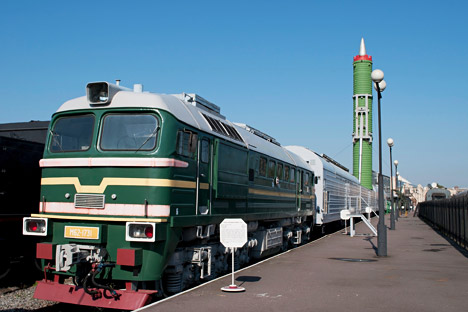
The "Molodets" rail-mobile ballistic missile system. Source: Lori / Legion Media
Due to the absence of armor on the wagons, this train is not used in combat and operates only in the rear.
The train's facilities help satisfy the troops' everyday sanitary needs: from washing uniforms to disinfecting soldiers. The logistics train is also equipped with all the modern communication devices that help staff officers carry out their functions: radio, telephone, telegraph, satellite and video conferencing technology. The presence of a 2MW electric power generator (the power capacity of a small factory) makes the train independent in terms of energy consumption. The logistics train was included in all the Center 2015 large-scale exercises that took place in September in the Central Military District.
Combat rail missile systems are needed to respond to a nuclear strike in the event of an attack. The USSR had 12 specialized trains with 15P961 Molodets missile systems installed. Each train contained three strategic missiles with 10 Stilet warheads.

The combat rail missile system. Museum of railway equipment. Source: PhotoXPress
Combat rail missile systems were on combat duty from 1987 to 1994, after which, under the terms of the START II treaty, Russia pledged to liquidate all the RT-23 Molodets missiles. In 2013 the Russian government decided to revive the combat rail missile systems.
The new rail missile system, camouflaged as refrigerated cars, will be equipped with the new Russian intercontinental ballistic missile with the Yars multiple warhead.
During the antiterrorist operation in the North Caucasus between 2002 and 2009 the military created an entire group of armored trains. Former Defense Minister Anatoly Serdyukov ordered the special trains to be removed for conservation, but current Defense Minister Sergei Shoigu decided to return the trains to service.
The main objectives of the modern special armored trains are to protect civilian and military trains, as well as to prevent terrorist acts intended to sabotage railroad tracks, as the armored trains are transporting personnel.
Currently, Russia has four armored trains – the Baikal, Terek, Amur and Don. They served in the late 1980s on the Soviet-Chinese border.
All rights reserved by Rossiyskaya Gazeta.
Subscribe
to our newsletter!
Get the week's best stories straight to your inbox